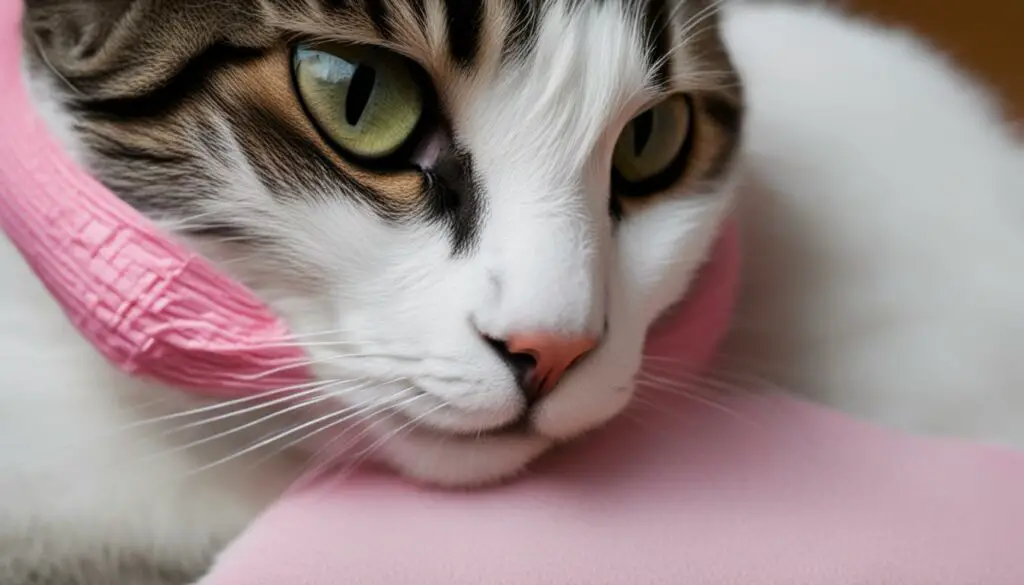As a cat owner, you never want to see your furry friend in pain. Whether it’s a minor cut, a surgical incision, or an injury, you want to provide them with the best care possible. One of the ways to ease your cat’s discomfort and promote healing is by using a cat neck bandage.
Bandages and splints are essential tools in protecting your cat’s neck wound or injury, preventing them from causing further harm to themselves and allowing the wound to heal properly. These bandages can be applied to various parts of your cat’s body, including the head, neck, chest, tail, and lower legs.
Key Takeaways:
- Bandages and splints provide protection and support for your cat’s neck wound or injury.
- Cat neck bandages minimize pain, swelling, and discomfort.
- They promote faster and safer healing by keeping the wound clean and protected.
- The bandage consists of multiple layers, such as a dressing layer, padding layer, protective layer, and surgical tape.
- Proper bandage care and regular monitoring are crucial for your cat’s health and well-being.
Reasons to Use a Cat Neck Bandage
A cat neck bandage is an essential tool for providing care and support to a cat with a neck wound or injury. These bandages serve multiple purposes and offer several benefits for the well-being and recovery of your furry friend.
- Protection from self-trauma: Cats have a natural instinct to groom and clean themselves, which can be a problem when they have a neck wound. A bandage helps to prevent the cat from licking or scratching the area, reducing the risk of further damage or infection.
- Pain relief and comfort: Neck injuries can be painful and uncomfortable for cats. A neck bandage provides support and stability, minimizing movement and reducing pain. It helps to alleviate discomfort and allows the cat to heal more comfortably.
- Promotion of healing: By keeping the wound clean and protected, a cat neck bandage creates an optimal environment for healing. It acts as a barrier against dirt and debris, reducing the risk of contamination. Additionally, the bandage can hold medication in place, ensuring proper delivery and maximizing the effectiveness of treatments.
- Prevention of complications: Neck wounds can be prone to complications such as infection or reopening of the wound. A bandage helps to prevent these complications by creating a protective barrier and immobilizing the injured area. It plays a crucial role in minimizing the risk of further issues and promoting a smooth recovery.
Overall, a cat neck bandage is a valuable tool for providing care and support to a cat with a neck wound or injury. It helps to protect the wound, reduce pain, promote healing, and prevent complications. When used properly, a cat neck bandage can significantly contribute to your cat’s recovery and well-being.
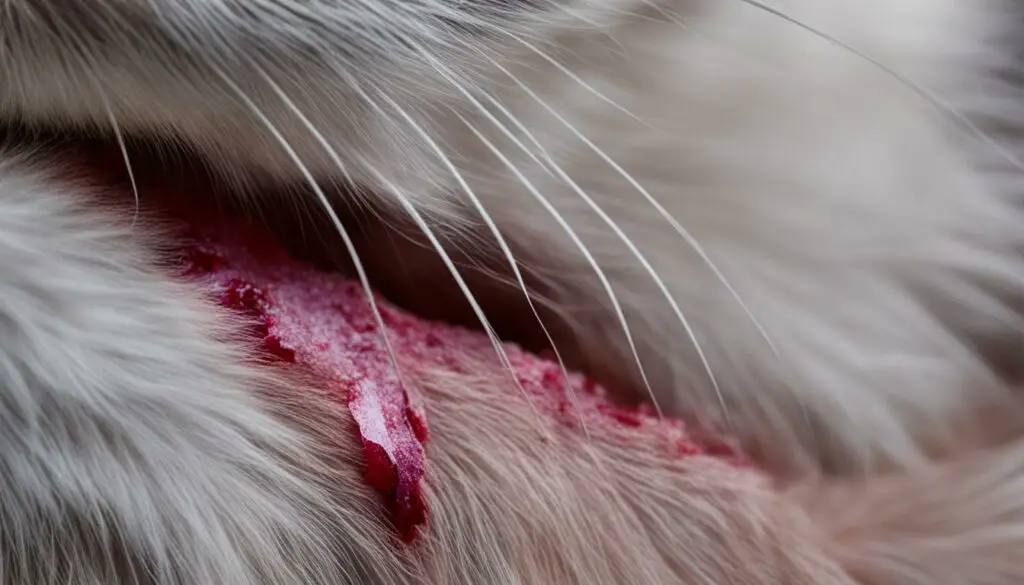
Table: Comparison of Bandage Types for Cat Neck Wounds
| Bandage Type | Advantages | Disadvantages |
|---|---|---|
| Traditional Cloth Bandage |
|
|
| Self-Adhesive Bandage |
|
|
Parts of the Body that Can Be Protected by a Bandage or Splint
When it comes to providing support and protection for a cat’s wounds or injuries, bandages and splints can be applied to various parts of their body. In addition to the neck, bandages can also be used to protect the head, chest, tail, and lower legs. These bandages help to stabilize the injured area, prevent movement, and minimize further damage. They provide support and promote healing, making them an essential part of feline wound care.
Aside from the neck, other areas that can benefit from the use of bandages or splints include the ears, toes, and joints. These areas are vulnerable to injuries that can be aggravated by movement or self-trauma. By properly applying bandages or splints to these areas, cat owners can ensure that their furry friends‘ wounds are protected and given the opportunity to heal effectively.
The Importance of Cat Neck Support
Cat neck support is particularly crucial when it comes to neck wounds or injuries. The neck bandage provides the necessary stability and protection for these delicate areas. By immobilizing the injured part, the bandage helps to prevent unnecessary movement or stress that could hinder the healing process. It also helps to minimize pain and discomfort, allowing the cat to recover more comfortably. With proper support and protection, a cat’s neck can heal more effectively, contributing to their overall health and well-being.
| Areas That Can Be Protected by Bandages or Splints | Benefits |
|---|---|
| Head | Prevents self-trauma to facial wounds or injuries |
| Chest | Supports and protects wounds on the chest or upper body |
| Tail | Helps stabilize and protect tail wounds or injuries |
| Lower legs | Provides support and immobilization for leg wounds or injuries |
| Ears | Protects ear wounds or injuries from self-trauma or contamination |
| Toes | Stabilizes and shields wounds or injuries on the toes or paw pads |
| Joints | Supports injured joints, minimizing movement and further damage |
By understanding the parts of a cat’s body that can be protected by bandages or splints, cat owners can ensure that their feline companions receive the appropriate care and support they need to heal effectively. Whether it’s a neck wound or an injury to another area of the body, proper bandaging techniques can make a significant difference in promoting the cat’s health and recovery.
Understanding the Layers of a Cat Neck Bandage
When it comes to a feline neck bandage, understanding its layers is crucial for effective wound care and cat healing. Each layer plays a specific role in ensuring the bandage’s functionality and comfort for the cat. Let’s take a closer look at these layers:
Dressing Layer
The dressing layer is the first layer of the cat neck bandage. It serves as a barrier between the wound and the outer environment. This layer can be sterile or contain medication to treat infections. It is important to ensure the dressing layer is clean and free from debris to promote proper healing.
Padding Layer
The padding layer provides cushioning and support to the wound area. Rolled gauze, cotton, or synthetic cast padding are commonly used materials for this layer. The padding layer helps to absorb excess moisture, protect the wound from further trauma, and enhance the cat’s comfort.
Protective Layer
The third layer of the cat neck bandage is a strong and stretchy material. This layer protects the underlying layers, prevents moisture from reaching the wound, and offers additional support. It is crucial to ensure this layer is applied with proper tension, not too tight to restrict blood flow but tight enough to secure the bandage in place.
Final Layer
The final layer of the cat neck bandage is surgical tape. This layer secures the ends of the bandage, preventing the cat from removing it. It is important to check the tape regularly to ensure it remains intact and does not cause discomfort or irritation to the cat’s skin.
Understanding the layers of a cat neck bandage is essential for cat owners providing wound care to their furry friends. Each layer plays a crucial role in promoting healing, protecting the wound, and ensuring the cat’s comfort throughout the recovery process.
The Difference Between a Splint and a Bandage
When it comes to providing support and protection for a cat’s neck wound or injury, understanding the difference between a splint and a bandage is essential. While both serve the purpose of safeguarding the wound and promoting healing, they have distinct characteristics and applications.
A splint incorporates a hard or rigid material within the bandage to immobilize the injured part. It is often used to support fractured bones and provide additional stability. Splints are applied to both the joint above and below the fracture, ensuring proper alignment. They offer a higher level of rigidity and are suitable for injuries that require immobilization and enhanced protection.
A bandage, on the other hand, primarily focuses on protecting the wound, providing support, and preventing self-trauma. It consists of multiple layers, including a dressing layer, padding layer, protective layer, and a final layer of surgical tape. Bandages are particularly useful for surgical incisions, non-infected wounds, and injuries that require stabilization without the need for rigid support.
Ultimately, the choice between a splint and a bandage depends on the nature of the injury and the desired level of stability. Consulting with a veterinarian will help determine the most appropriate approach to ensure effective wound care and the cat’s overall well-being.
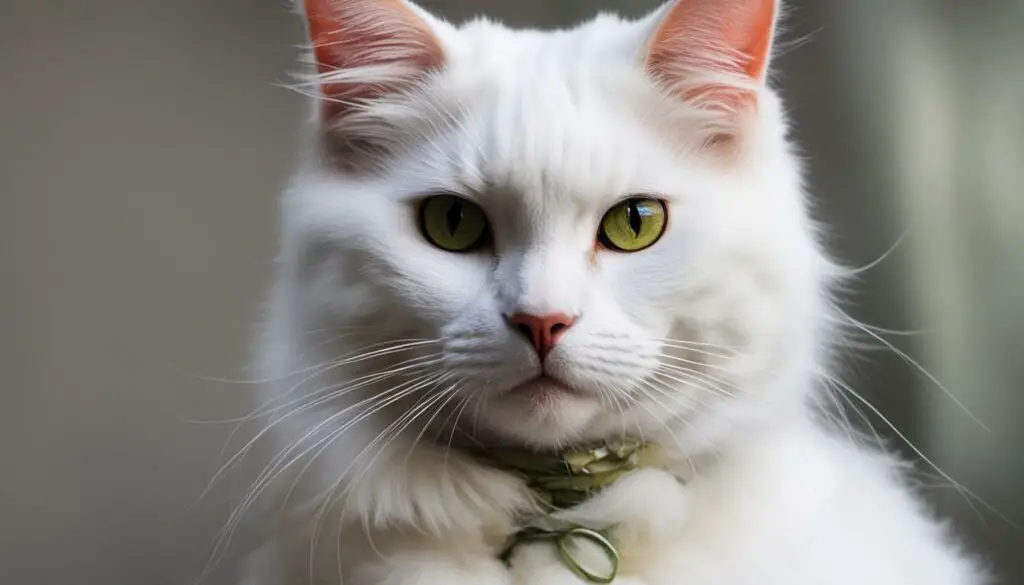
Comparing Splints and Bandages
| Splint | Bandage |
|---|---|
| Provides rigid support | Provides support without rigidity |
| Used for fractures and injuries requiring immobilization | Used for surgical incisions and non-infected wounds |
| Offers enhanced stability | Offers protection and stabilization |
| Incorporates hard or rigid materials | Consists of multiple layers and surgical tape |
Changing and Caring for a Cat Neck Bandage
Properly changing and caring for a cat neck bandage is crucial for the cat’s well-being and the effectiveness of the bandage in promoting healing. The frequency of changing the bandage depends on the specific wound and the cat’s healing progress. If the wound is infected, it may need to be changed one to two times per day until the infection is under control. Splints, on the other hand, are changed less frequently, typically once a week for growing kittens or several weeks for adult cats.
Regular monitoring of the bandage is important to ensure its cleanliness, tightness, and the absence of any signs of irritation. The area around the bandage should be checked for swelling, redness, or other indications of infection. It is essential to follow the veterinarian’s instructions for bandage care and not remove it unless advised by the veterinarian. These care practices help in maintaining a clean and protected environment for optimal healing.
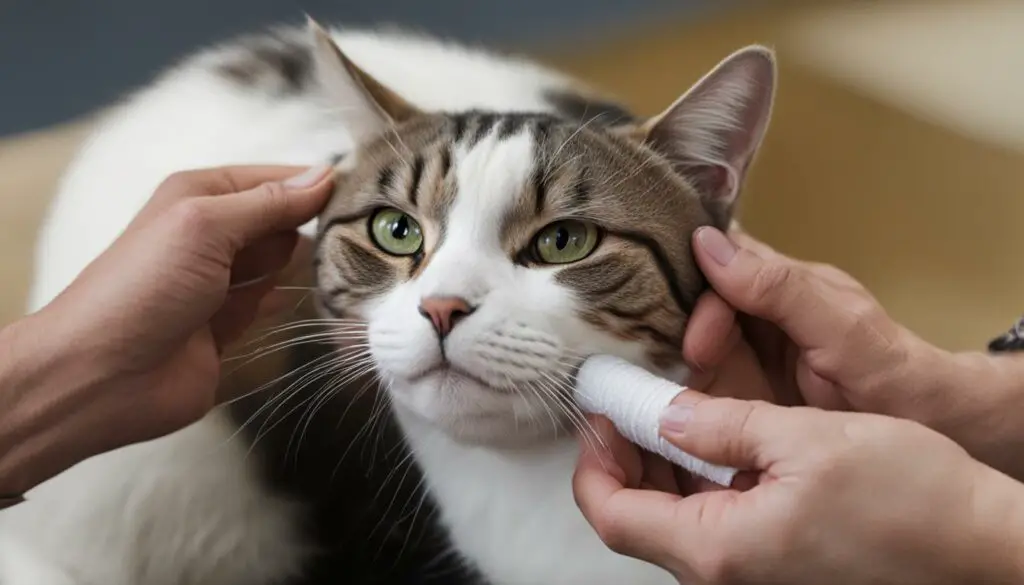
When changing the bandage, it is important to have clean supplies ready, including bandages, medical tape, scissors, and cotton balls or pads. It is crucial to secure the cat gently and comfortably during the process to prevent agitation. Before applying a new bandage, the wound should be carefully examined to determine its severity and whether further veterinary care is needed. If the wound is superficial and not bleeding, it can be cleaned with antiseptic solution or water.
By following proper changing and caring procedures, cat owners can play an active role in supporting their furry friends’ healing process, promoting faster recovery, and minimizing the risk of complications.
Accommodating a Cat with a Neck Bandage
When a cat requires a neck bandage, it is important to make certain accommodations to ensure their comfort and safety throughout the healing process. One such adjustment may involve modifying the litter box. Using a box with lower sides or a wider box can accommodate the increased bulk of the bandage. Additionally, it may be necessary to clean the litter box more frequently to prevent soiling the bandage. In some cases, a different type of litter may be necessary to avoid clumping litter getting stuck between the cat’s toes or sticking to a damp bandage. By addressing these litter box considerations, we can help the cat maintain good hygiene and prevent any complications that may arise from an unclean bandage.
Furthermore, it is essential to keep the cat confined indoors while the bandage is in place. This will prevent further injury or self-trauma that could hinder the healing process. Cats are naturally curious and may engage in activities that could jeopardize the bandage’s integrity, such as climbing or squeezing into tight spaces. By creating a safe and secure indoor environment for the cat, we can encourage a smooth recovery.
When making these accommodations, it is important to pay close attention to the cat’s behavior and well-being. Any signs of discomfort, agitation, or distress should be addressed promptly. If necessary, consult with a veterinarian for additional guidance and support. By providing the necessary accommodations and closely monitoring the cat’s progress, we can ensure their comfort and expedite their healing process.
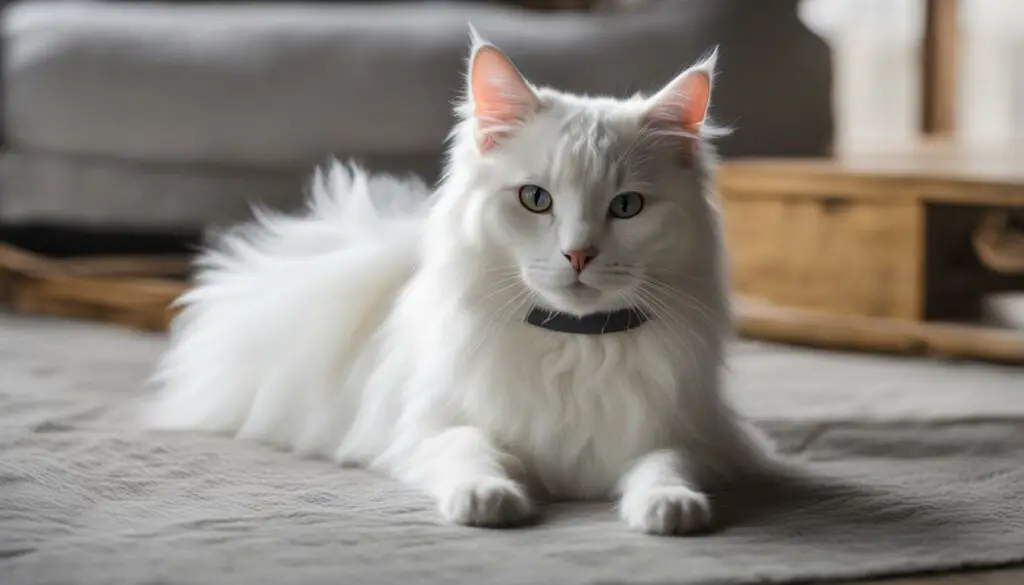
Accommodating a Cat with a Neck Bandage:
- Modify the litter box by using a box with lower sides or a wider box to accommodate the increased bulk of the bandage.
- Clean the litter box more frequently to prevent soiling the bandage.
- Consider using a different type of litter to avoid clumping litter sticking to the bandage.
- Keep the cat confined indoors to prevent further injury or self-trauma.
- Monitor the cat’s behavior and well-being closely, seeking veterinary guidance if needed.
When to Seek Veterinary Care for a Cat Neck Bandage
As a responsible cat owner, it’s important to know when to seek veterinary care for your cat’s neck bandage. While routine bandage changes can be managed at home with proper guidance, certain situations require immediate professional attention. By recognizing the warning signs, you can ensure your cat’s well-being and the success of their recovery.
Potential Signs of Complications
There are several signs that indicate the need for veterinary care. If you notice your cat chewing on the bandage, it could lead to further injury or the bandage becoming loose, risking self-trauma. Additionally, a wet or soiled bandage may indicate an underlying issue, such as an infection, that requires veterinary assessment. If the bandage appears to be too tight or too loose, it needs to be readjusted by a professional.
Other concerning signs include swelling, change in color around the wound area, excessive pain, or any unusual behavior or discomfort exhibited by your cat. These symptoms may indicate an infection, poor wound healing, or an underlying issue that needs to be addressed by a veterinarian.
It’s essential to follow the guidelines provided by your veterinarian regarding bandage changes and scheduled recheck appointments. However, if you observe any of the aforementioned signs or have any concerns about your cat’s neck bandage, it’s always best to err on the side of caution and seek veterinary care.
How to Wrap a Cat’s Neck Wound
When it comes to wrapping a cat’s neck wound, proper technique and preparation are key to ensure the wound is protected and the cat is comfortable. Before beginning the process, gather the necessary supplies, including bandages, medical tape, scissors, and cotton balls or pads. It’s important to handle the cat gently and securely during the wrapping process to minimize stress and agitation.
Start by carefully examining the neck wound to assess its severity and determine if further veterinary care is needed. If the wound is superficial and not actively bleeding, clean it with an antiseptic solution or water. Be sure to use gentle, slow movements to avoid causing any additional discomfort or pain to the cat. Once the wound is cleaned and dried, you can begin the wrapping process.
Proper wrapping techniques are crucial to ensure the bandage stays in place and provides the necessary support and protection. Consider using vet wrap, a self-adhesive elastic bandage specifically designed for animals. Start by wrapping the bandage snugly around the neck, making sure it is secure but not too tight. Continue wrapping in a spiral motion, overlapping each layer by approximately half of the previous layer. Secure the ends of the bandage with medical tape, making sure they are firmly attached.
Throughout the wrapping process, monitor the cat’s reaction and behavior to ensure they are comfortable. If the cat shows signs of distress or discomfort, consider taking a break and resuming the wrapping later when they are more relaxed. Remember to never force the wrapping on the cat if they are resistant or aggressive. It’s always best to seek professional veterinary assistance if you are uncertain or uncomfortable with the wrapping process.
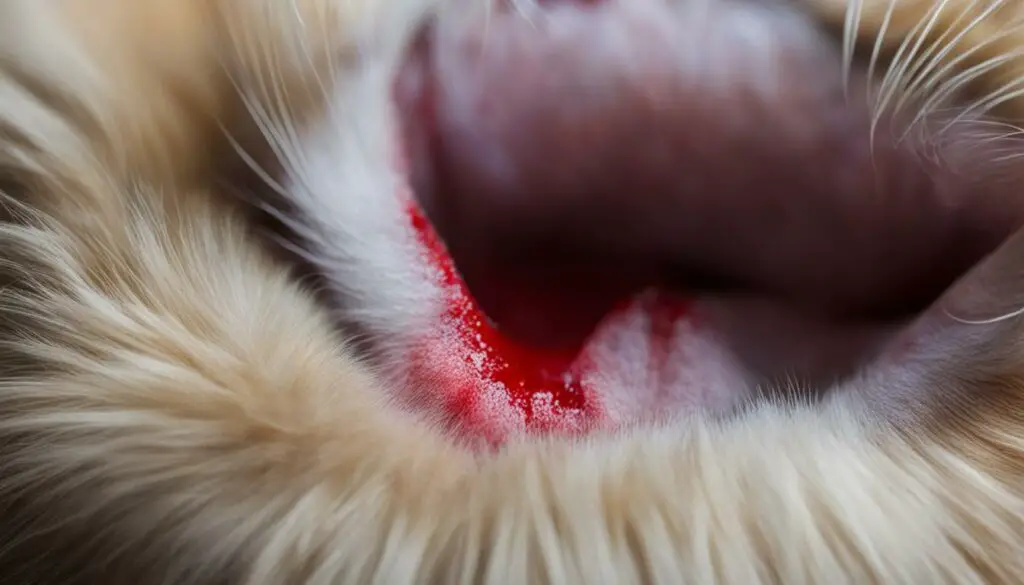
Table: Step-by-Step Guide to Wrapping a Cat’s Neck Wound
| Step | Description |
|---|---|
| 1 | Gather the necessary supplies, including bandages, medical tape, scissors, and cotton balls or pads. |
| 2 | Carefully examine the neck wound to assess its severity. |
| 3 | Clean the wound with an antiseptic solution or water, using gentle movements. |
| 4 | Wrap a self-adhesive elastic bandage, like vet wrap, around the neck. |
| 5 | Continue wrapping in a spiral motion, overlapping each layer. |
| 6 | Secure the ends of the bandage with medical tape. |
| 7 | Monitor the cat’s behavior throughout the process and seek veterinary assistance if needed. |
Reasons to Wrap a Cat’s Neck Wound
When a cat sustains a neck wound or injury, wrapping the wound with a cat neck bandage is crucial for several reasons. First, it helps keep the wound clean and protected from further injury, contamination, and self-trauma. By creating a barrier between the wound and the environment, the bandage minimizes the risk of infection and speeds up the healing process. It also reduces pain, swelling, and discomfort, providing relief for the cat and promoting a faster recovery.
Furthermore, a cat neck bandage can help prevent the cat from scratching or licking the wound. Cats have a natural instinct to groom themselves, and when faced with a wound, they may try to clean or scratch it, leading to further damage. The bandage acts as a physical barrier, preventing the cat from accessing the wound and enabling it to heal undisturbed. This is particularly important for wounds that require stitches or surgical incisions, as excessive licking or scratching can cause the sutures to come undone and delay the healing process.
Additionally, wrapping a cat’s neck wound with a bandage provides support and stability to the injured area. The bandage helps to immobilize the wound, reducing movement and minimizing the risk of further injury. This is especially beneficial for neck wounds, as the neck is a highly mobile area. By restricting movement, the bandage allows the cat’s body to focus its energy on healing the wound rather than on unnecessary muscle activity.
Table: Comparison of Wrapped and Unwrapped Cat Neck Wounds
| Wrapped Neck Wound | Unwrapped Neck Wound | |
|---|---|---|
| Protection | The wound is protected from contamination and self-trauma. | The wound is exposed to the environment, increasing the risk of infection and further injury. |
| Pain Relief | The bandage reduces pain, swelling, and discomfort. | The cat experiences more pain and discomfort. |
| Healing Time | The bandage promotes faster healing by creating an optimal environment for wound recovery. | The healing process may take longer due to potential complications and slower tissue regeneration. |
| Mobility | The bandage restricts movement, minimizing the risk of further injury. | The cat has unrestricted movement, increasing the likelihood of aggravating the wound. |
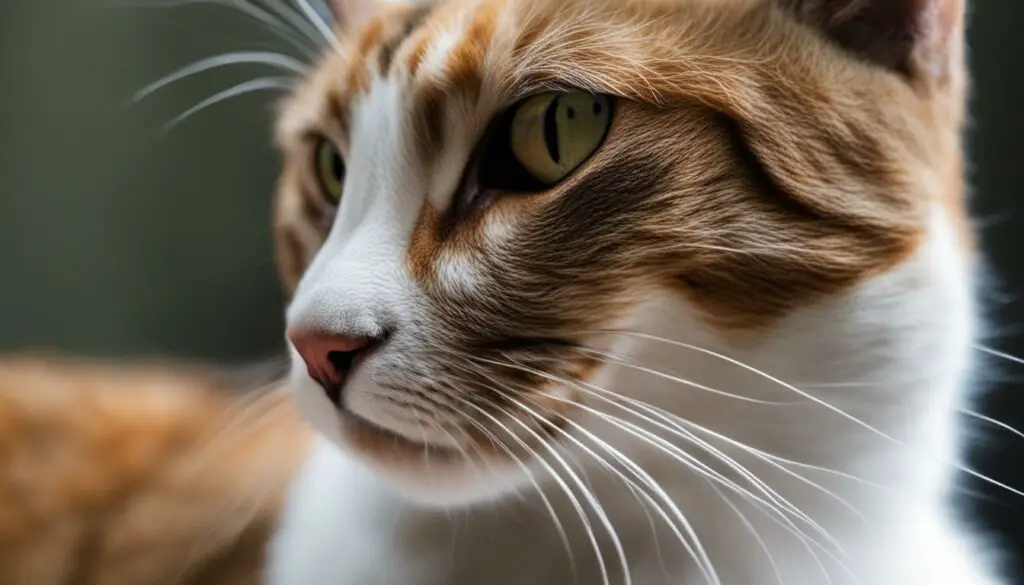
A cat neck bandage is a valuable tool in ensuring the well-being and recovery of a cat with a neck wound or injury. By wrapping the wound, cat owners can protect it from contamination, minimize pain and discomfort, prevent self-trauma, and promote faster healing. It’s important to use proper techniques and materials to ensure the bandage is secure and comfortable for the cat. If in doubt, it’s always best to consult a veterinarian for guidance on how to properly wrap and care for a cat’s neck wound.
How to Assess and Clean a Cat’s Neck Wound
Assessing and cleaning a cat’s neck wound is a crucial step in ensuring proper wound care. To assess the wound, start by gently stopping any bleeding by applying direct pressure with a clean cloth or sterile gauze. Next, examine the wound for its severity and determine if further veterinary assistance is needed. If the wound is small and superficial, it can be cleaned with an antiseptic solution or water using a syringe for flushing if necessary. However, if the wound is large, deep, or shows signs of infection, it is best to disinfect around the wound and seek professional veterinary care.
When cleaning the wound, it is important to avoid using alcohol or hydrogen peroxide as they can damage the tissue and delay healing. Instead, use a gentle antiseptic solution recommended by your veterinarian. Gently clean the area surrounding the wound, being careful not to further irritate or cause pain to your cat. If the wound is too sensitive or painful to clean, it is best to consult a veterinarian for proper wound care.
Regular monitoring of the wound is crucial to identify any signs of infection or worsening condition. Look for swelling, redness, pain, or the presence of discharge such as blood or pus. If any of these signs are observed, it is essential to contact a veterinarian for evaluation and appropriate treatment. Prompt medical attention can prevent complications and ensure the best outcome for your cat’s health and well-being.
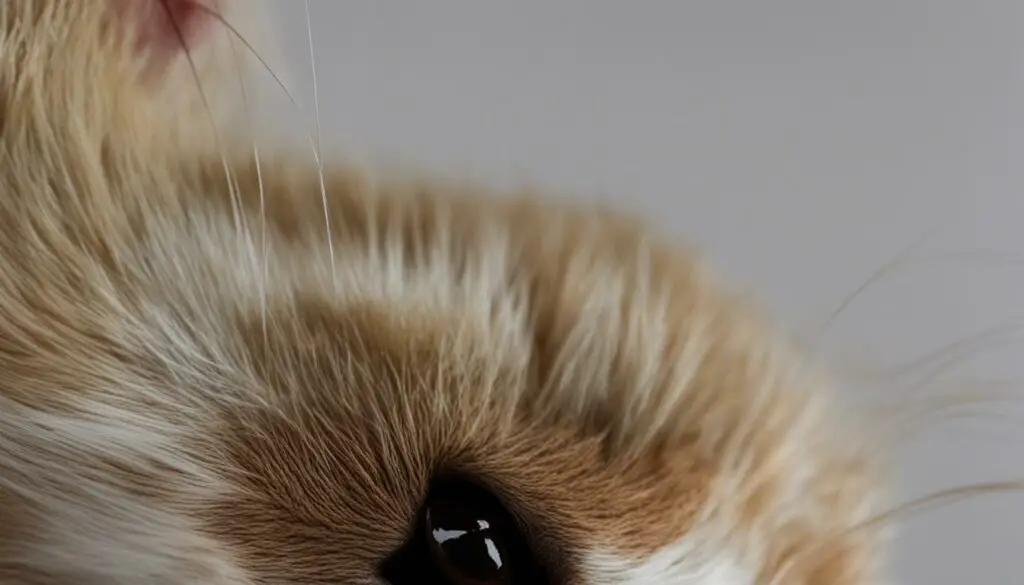
Table: Signs of an Infected Wound on a Cat
| Signs of an Infected Wound on a Cat |
|---|
| Swelling |
| Redness |
| Pain or tenderness |
| Warmth around the wound |
| Discharge (such as blood or pus) |
| Fever |
| Lethargy |
| Vomiting or diarrhea (if the wound is on a leg) |
Recognizing the signs of an infected wound on your cat is important to ensure timely medical attention. If any of these signs are present, it is crucial to contact your veterinarian for evaluation and appropriate treatment. Delaying treatment for an infected wound can lead to further complications and a worsened condition for your cat. By promptly addressing an infected wound, you can help facilitate the healing process and prevent any potential harm to your feline friend.
Preventing a Cat from Licking Their Neck Wound
When a cat sustains a neck wound, it is important to prevent them from licking or scratching the affected area. Cats’ natural grooming instincts can hinder the healing process and introduce bacteria to the wound, leading to infection and further complications. To prevent a cat from licking their neck wound, the use of an Elizabethan collar, commonly known as an e-collar, is highly recommended.
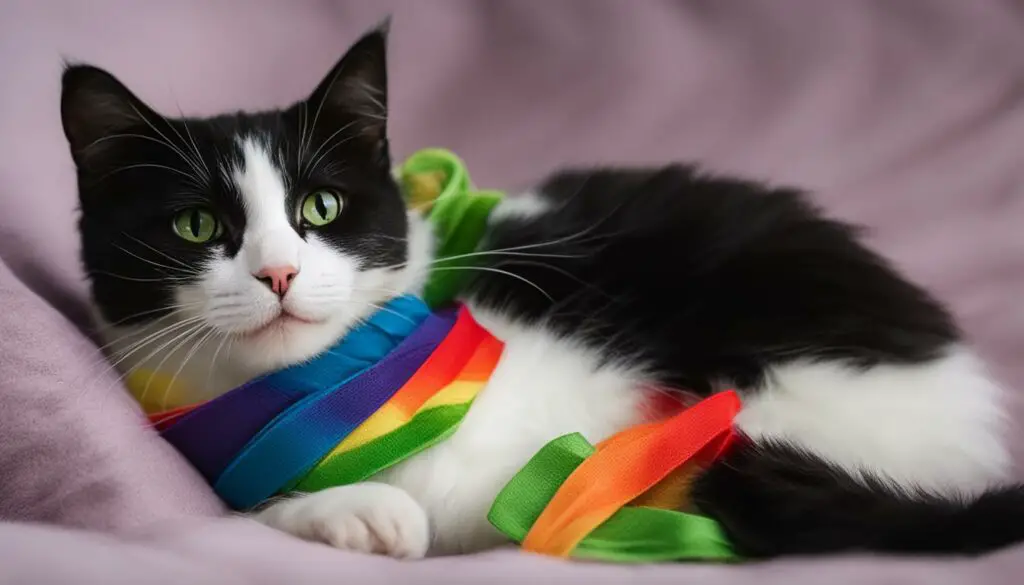
The e-collar is a plastic cone-shaped device that fits around the cat’s neck, forming a barrier between their mouth and the wound. It prevents them from accessing the wound and offers protection during the healing process. The e-collar should be properly measured to fit the cat comfortably without restricting their daily activities. It should be worn consistently, even when supervised, to ensure the cat cannot reach the wound.
It is important to note that cats may initially find the e-collar uncomfortable or distressing. They may try to remove or resist wearing it. However, with patience and proper introduction, most cats adjust to wearing the e-collar within a few days. Providing additional distractions, such as interactive toys or puzzles, can help alleviate any stress or boredom associated with wearing the collar.
In addition to using an e-collar, it is crucial to follow proper wound care guidelines provided by a veterinarian. Keeping the wound clean, dry, and protected is essential for optimal healing. Regular monitoring for signs of infection, such as redness, swelling, or discharge, is also crucial. If any concerning symptoms arise or if there are any issues with the cat’s behavior, it is important to seek veterinary care.
Types of Cat Wounds and When to Seek Veterinary Care
When it comes to cat wounds, it’s important to know the different types and when to seek veterinary care. Cat wounds can range from minor cuts and abrasions to more severe puncture wounds, bite wounds, and abscesses. Understanding the nature of the wound is crucial in determining the appropriate course of action.
Puncture wounds and bite wounds are common injuries in cats, especially those that spend time outdoors or engage in fights with other animals. These types of wounds can be deceptive as they may appear small on the surface but can cause significant damage internally. It’s essential to seek veterinary care to assess and treat potential internal damage, as well as to prevent infection.
Minor cuts and abrasions can often be treated at home with proper wound care. Cleaning the wound with an antiseptic solution or water and keeping an eye out for signs of infection, such as redness, swelling, or discharge, is important. If the wound shows signs of worsening or if the cat’s behavior changes, it’s advisable to consult a veterinarian.
Abscesses are walled-off infections that require professional treatment. They often occur as a result of bite wounds and can be quite painful for the cat. Veterinary care is necessary to drain and clean the affected area, as well as to prescribe appropriate antibiotics to combat the infection.
| Types of Cat Wounds | When to Seek Veterinary Care |
|---|---|
| Puncture wounds and bite wounds | Immediately, to assess potential internal damage |
| Minor cuts and abrasions | If signs of infection or worsening are observed |
| Abscesses | Immediately, to drain and treat the infection |
It’s crucial to pay close attention to the cat’s behavior and monitor the wound for any signs of infection or complications. Seeking veterinary care when necessary ensures proper healing and prevents further complications. Remember, the earlier a cat’s wound is addressed, the better the chances for a successful recovery.
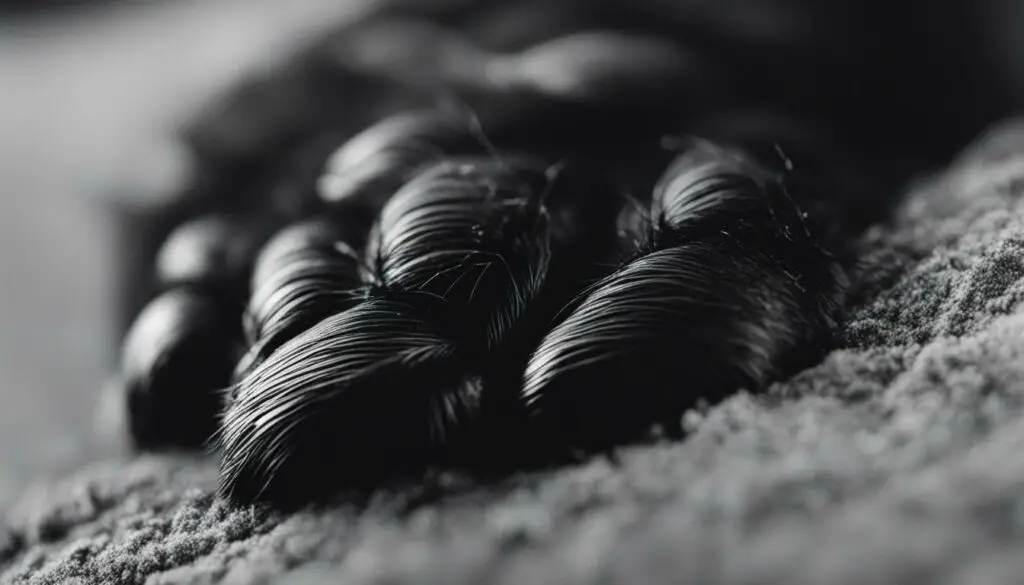
Signs of an Infected Wound on a Cat
A cat’s wound can easily become infected if not properly cared for. It’s important for cat owners to be able to recognize the signs of an infected wound so that they can seek veterinary attention promptly. Here are some common signs to look out for:
- Swelling: An infected wound may appear swollen and feel warm to the touch. The surrounding area may be puffy and tender.
- Redness: Inflammation can cause the wound to become red or even slightly purple in color.
- Pain: An infected wound can be painful for the cat. They may react when the area is touched or try to avoid any contact with it.
- Discharge: Infected wounds may produce discharge, such as blood or pus. It may have a foul odor and can be visible on the surface of the wound.
- Systemic symptoms: In more severe cases, the cat may show systemic symptoms like fever, lethargy, vomiting, diarrhea, or lameness if the wound is on a leg.
If any of these signs are observed, it is important to contact a veterinarian for evaluation and appropriate treatment. Ignoring an infected wound can lead to complications and worsen the cat’s condition. A veterinarian will be able to assess the wound, prescribe necessary medications, and provide further instructions for wound care.
| Signs of an Infected Wound on a Cat | Description |
|---|---|
| Swelling | An infected wound may appear swollen and feel warm to the touch. The surrounding area may be puffy and tender. |
| Redness | Inflammation can cause the wound to become red or even slightly purple in color. |
| Pain | An infected wound can be painful for the cat. They may react when the area is touched or try to avoid any contact with it. |
| Discharge | Infected wounds may produce discharge, such as blood or pus. It may have a foul odor and can be visible on the surface of the wound. |
| Systemic symptoms | In more severe cases, the cat may show systemic symptoms like fever, lethargy, vomiting, diarrhea, or lameness if the wound is on a leg. |
Recognizing these signs early on and seeking veterinary care can prevent further complications and ensure that the cat’s wound heals properly. It’s always better to err on the side of caution when it comes to the health and well-being of our furry friends.
Conclusion
After understanding the importance of cat wound care, it’s clear that a cat neck bandage plays a vital role in promoting healing and protecting the wound. By using a bandage, cat owners can minimize pain, swelling, and discomfort, allowing their furry friends to recover more quickly and safely. Regular monitoring and careful attention to wound care are essential to prevent complications and ensure the best outcome for the cat’s health and well-being.
Whether it’s a cat neck wound or any other type of injury, seeking veterinary care when necessary is crucial. Signs of infection or worsening conditions should never be ignored, as prompt medical attention is key to preventing further complications. Additionally, proper wrapping techniques and the use of an Elizabethan collar are effective ways to prevent cats from licking or scratching their wounds, enabling the healing process to proceed smoothly.
Remember, cat wound care is a responsibility that should never be taken lightly. By providing the necessary support and protection through the use of a cat neck bandage, cat owners can play a significant role in their pet’s recovery. Stay vigilant, follow the veterinarian’s instructions, and be proactive in monitoring your cat’s progress. With proper care and attention, your feline friend will be back on their feet in no time.
FAQ
What is the purpose of a cat neck bandage?
A cat neck bandage is used to protect a cat’s neck wound or injury from self-trauma, contamination, and further damage. It helps minimize pain, swelling, and discomfort and promotes faster healing.
Where can bandages and splints be applied on a cat’s body?
Bandages and splints can be applied to various parts of a cat’s body, including the head, neck, chest, tail, and lower legs.
What are the layers of a cat neck bandage?
A cat neck bandage consists of multiple layers, including a dressing layer, a padding layer, a protective layer, and a final layer of surgical tape.
What is the difference between a splint and a bandage?
A splint incorporates a hard or rigid material to immobilize an injured part, while a bandage primarily focuses on protecting the wound and preventing self-trauma.
How often should a cat neck bandage be changed?
The frequency of changing a cat neck bandage depends on the specific wound and the cat’s healing progress. It may need to be changed one to two times per day for infected wounds or once a week for non-infected wounds.
How should a cat with a neck bandage be accommodated?
Cats with a neck bandage may require modifications to their litter box and should be kept indoors to prevent further injury or self-trauma.
When should veterinary care be sought for a cat neck bandage?
Veterinary care should be sought if the cat is chewing on the bandage, if the bandage is wet, soiled, foul-smelling, bleeding, too loose, too tight, or if there are any concerning signs such as swelling, change in color, excessive pain, or signs of infection.
How should a cat’s neck wound be wrapped?
A cat’s neck wound should be cleaned, and the bandage should be applied using proper wrapping techniques, such as using vet wrap and securing the ends, to protect the wound and reduce pain and swelling.
Why should a cat’s neck wound be wrapped?
Wrapping a cat’s neck wound helps keep the wound clean and protected from further injury, contamination, and self-trauma. It reduces pain, swelling, discomfort, and the cat’s urge to scratch or lick the area.
How should a cat’s neck wound be assessed and cleaned?
A cat’s neck wound should be assessed for severity, and if necessary, bleeding should be stopped by applying direct pressure. The wound can be gently cleaned with antiseptic solution or water, and veterinary assistance should be sought if the wound is large, deep, or concerning.
How can a cat be prevented from licking their neck wound?
To prevent a cat from licking their neck wound, an Elizabethan collar (e-collar) should be used. The e-collar should be properly measured and worn consistently to prevent the cat from accessing the wound.
What are common types of cat wounds and when should veterinary care be sought?
Common types of cat wounds include puncture wounds, bite wounds, minor cuts, abrasions, and abscesses. Veterinary care should be sought for puncture wounds, bite wounds, and abscesses, while minor cuts and abrasions may heal on their own with proper wound care, but monitoring for signs of infection is crucial.
What are the signs of an infected wound on a cat?
Signs of an infected wound on a cat include swelling, redness, pain, warmth, the presence of discharge (such as blood or pus), and systemic symptoms like fever, lethargy, vomiting, diarrhea, or lameness. Veterinary care should be sought if any of these signs are observed.
Source Links
- https://mypetsguide.com/how-to-wrap-a-cat-neck-wound/
- https://www.petmd.com/cat/general-health/wound-care-cats
- https://vcahospitals.com/know-your-pet/bandage-and-splint-care-in-cats

